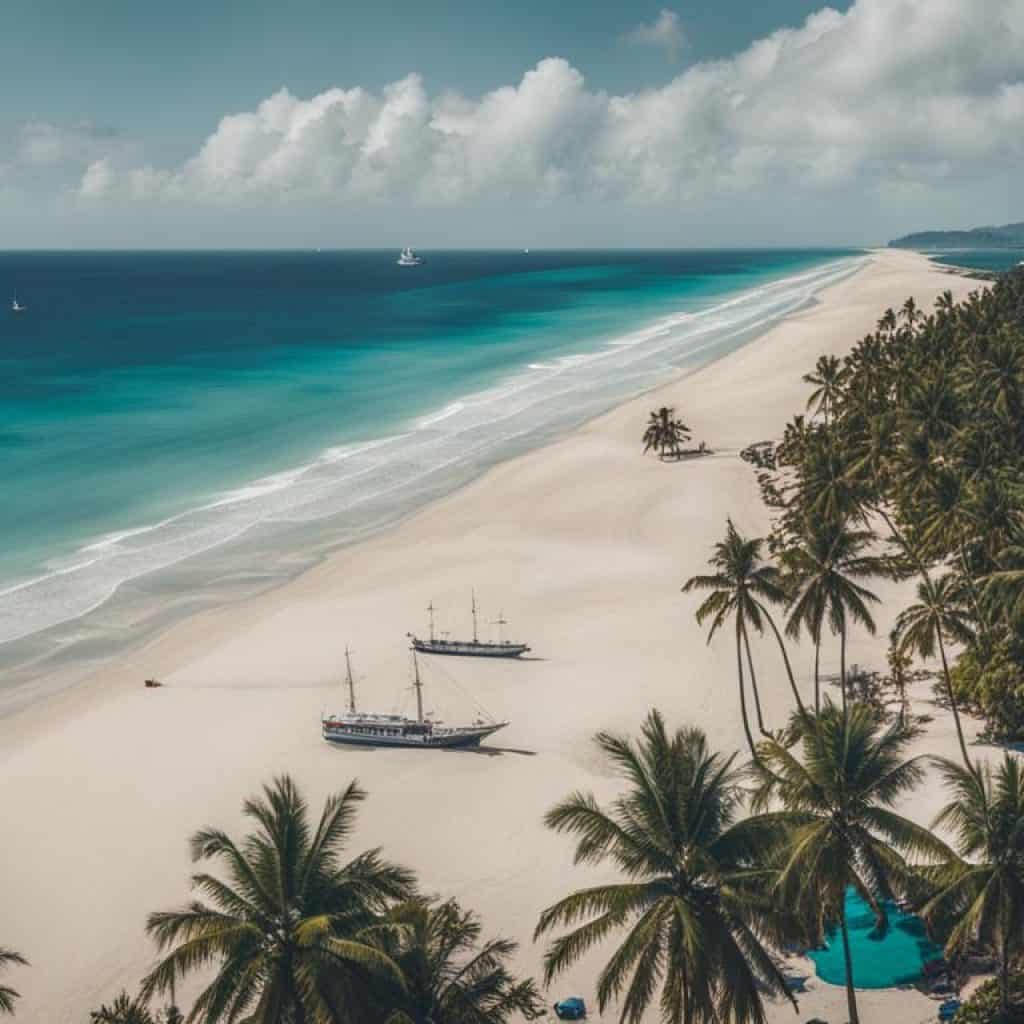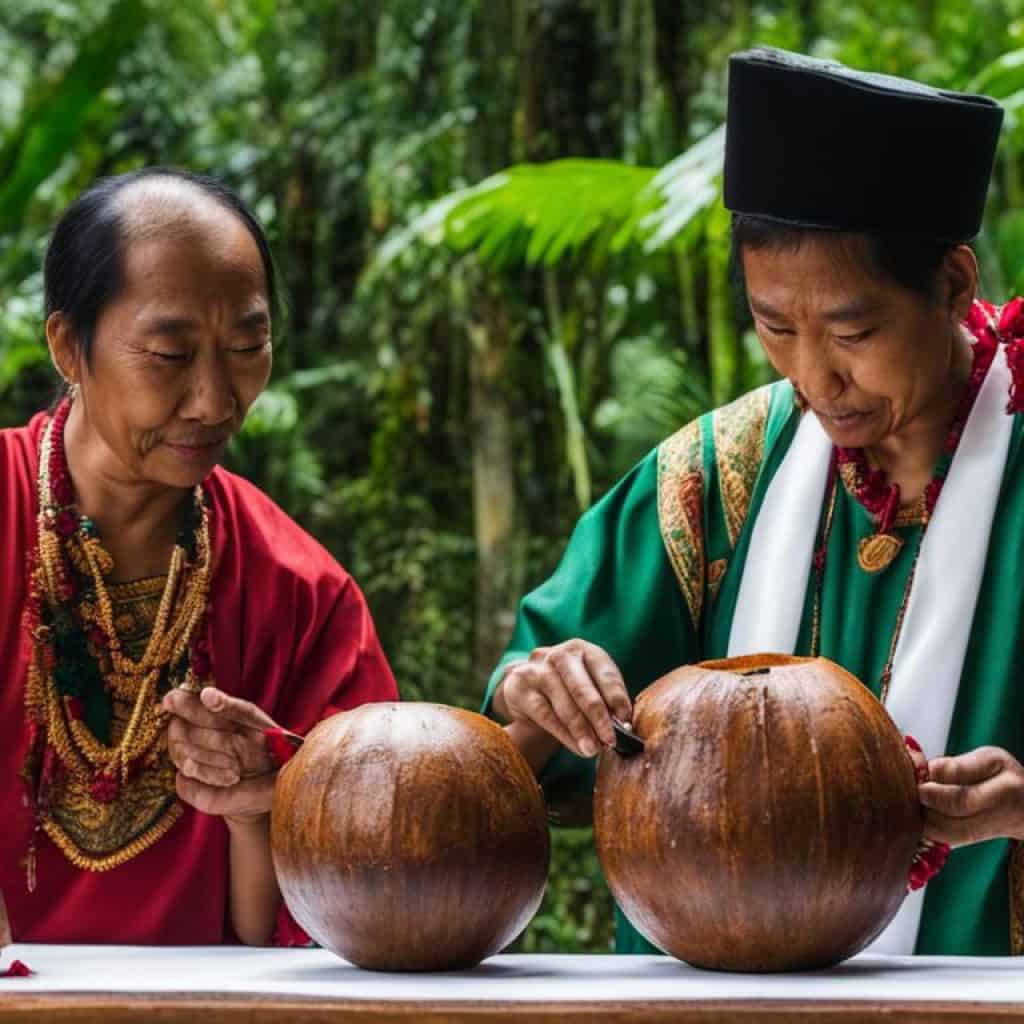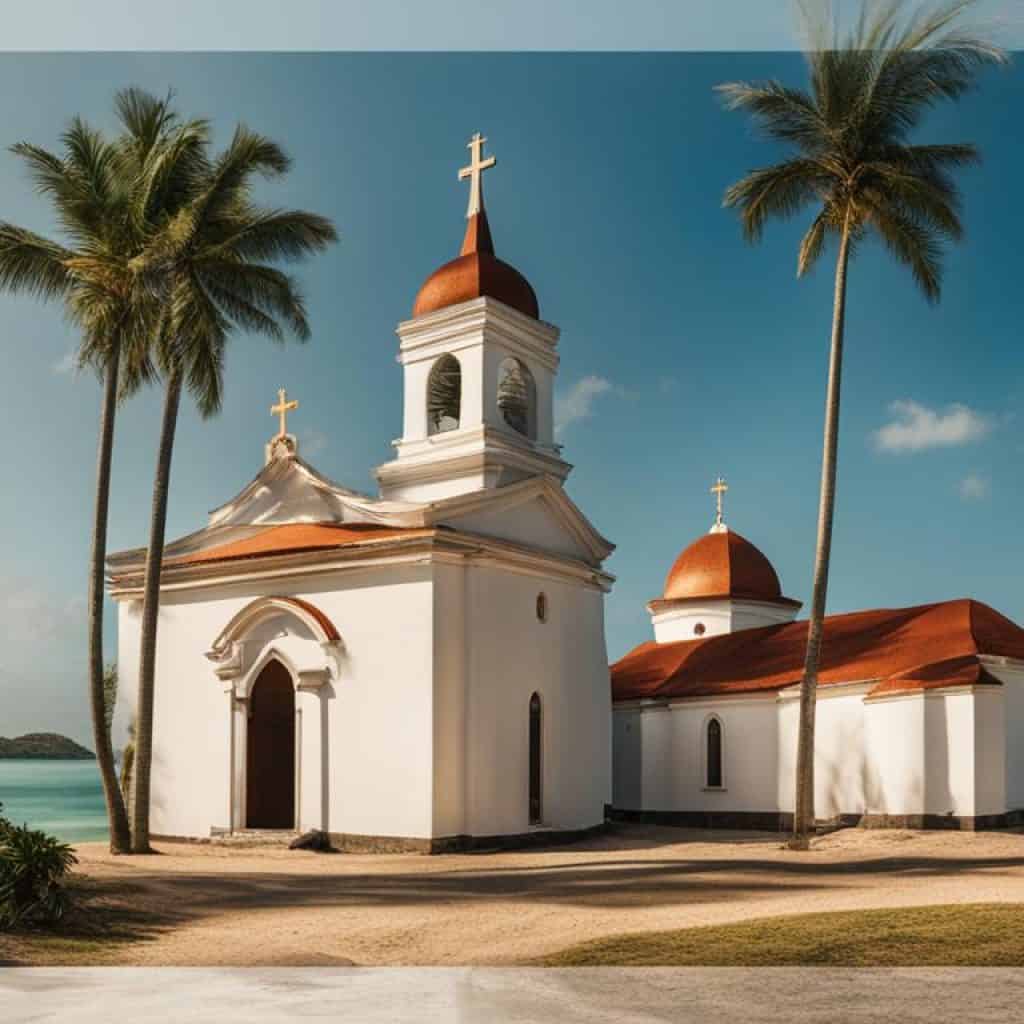Have you ever wondered where the first Catholic Mass in the Philippines took place? Many believe it happened in Butuan, but recent research suggests a different location altogether. Join us on a journey to uncover the truth behind the first Mass in the Philippines and discover the historical site where it most likely occurred.
As we delve into the fascinating history surrounding this pivotal event, we will explore the controversy, the eyewitness accounts, and the significance of the first Mass. Get ready to challenge common beliefs and unravel the mysteries of this momentous occasion in Philippine history.
Key Takeaways:
- The first Mass in the Philippines took place on March 31, 1521, marking the birth of Roman Catholicism in the country.
- The location of the first Mass has been a subject of debate, but recent research suggests it most likely occurred in Limasawa, Southern Leyte.
- Antonio Pigafetta’s eyewitness account provides valuable insights into the timing, participants, and location of the first Mass.
- The first Mass symbolizes the introduction of Christianity and the beginning of Spanish colonization in the Philippines.
- Understanding the significance and historical accuracy of the first Mass allows us to better comprehend the cultural and religious landscape of the Philippines.
Historical Events in the Philippines Before the First Mass
Before the first mass in the Philippines, the islands were home to diverse indigenous tribes and dynamic kingdoms. These native communities had rich histories and flourishing cultures, each contributing to the vibrant tapestry of the archipelago. The Philippines boasted a complex network of trade routes, artistic traditions, and political systems that date back centuries.
However, the arrival of the Spanish colonizers marked a turning point in Philippine history. The impact of colonization was profound, reshaping the social, political, and religious landscape of the islands. The introduction of Christianity through the first mass paved the way for centuries of Spanish influence and colonization.
“The first mass in the Philippines symbolizes the beginning of a transformative era in our history, where the native inhabitants were exposed to a new religion and confronted with the arrival of foreign powers.”
The process of colonization brought about significant changes to the Philippines. Spanish missionaries, accompanied by explorers and settlers, sought to convert the indigenous population to Catholicism. This religious conversion, coupled with the imposition of Spanish governance, resulted in the assimilation of native cultures into the larger Spanish colonial framework.
The repercussions of colonization can still be observed in various aspects of contemporary Philippine society, from religious practices to language and cuisine. The Spanish era, which began with the first mass, laid the foundation for intricate cultural syncretism and shaped the national identity of the Philippines as we know it today.
Impact on Indigenous Communities
The arrival of the Spanish colonizers had a multifaceted impact on the indigenous communities of the Philippines. While indigenous cultures were not completely eradicated, the influence of Spanish colonization often led to the marginalization and displacement of native populations.
The introduction of Christianity brought about significant changes to traditional belief systems and practices. Indigenous rituals and customs were often suppressed or modified to align with Catholic teachings. This assimilation led to the syncretism of indigenous and Catholic traditions, resulting in unique religious practices such as the inclusion of indigenous elements in Catholic festivals and devotions.
The Legacy of Colonization
The legacy of colonization is complex and continues to shape the Philippines. The fusion of Spanish and indigenous cultures produced a distinct Filipino identity that is characterized by a blend of Eastern and Western influences. Spanish architectural styles, religious festivals, and the Spanish language itself are visible reminders of this colonial legacy.
Furthermore, the Spanish colonial period has left an indelible mark on the political and social structures of the Philippines. The hierarchical system established by the Spanish, which favored the elite and perpetuated social inequalities, has persisted in various forms throughout history.
It is essential to acknowledge and understand the historical events that shaped the Philippines before the first mass. By recognizing the cultural resilience of indigenous communities and the impact of colonization, we gain a deeper appreciation for the complexities of Philippine history and the diverse society we have today.
Image shows an illustration of indigenous tribes and Spanish colonizers.
Ferdinand Magellan’s Voyages and Arrival in the Philippines
In the early 16th century, Ferdinand Magellan, a Portuguese explorer commissioned by the Spanish crown, embarked on a daring expedition to discover a western route to the fabled Spice Islands. Magellan’s Philippine expedition, which began in 1519, would prove to be a significant chapter in the history of exploration and the Philippines itself.
After months of navigating treacherous waters and enduring hardships, Magellan and his crew finally reached the shores of the Philippines on March 16, 1521. Their arrival on the island of Mazaua (now believed to be Limasawa) marked their first encounter with the native inhabitants of the archipelago. It was a momentous occasion, setting the stage for the subsequent events that would shape the course of Philippine history.
Magellan’s arrival in the Philippines opened up a world of cultural exchange and exploration. It was an opportunity for Europeans to establish diplomatic relations with indigenous communities and initiate trade. The interactions between Magellan’s crew and the locals provided a glimpse into the diverse cultures and traditions of the Philippine islands.
Quote: “We saw a village on the seashore, and there we landed with our small boats. We proceeded to the king, who came forth to receive us under a canopy, borne by several men. We gave him several presents, and he showed us his gratitude by exchanging gifts with us.” – Antonio Pigafetta, Survivor of Magellan’s Expedition
*The image below illustrates Ferdinand Magellan’s voyage and arrival in the Philippines
| Year | Event |
|---|---|
| 1519 | Magellan’s expedition departs from Spain |
| 1520 | Magellan reaches South America and discovers the Strait of Magellan |
| 1521 | Magellan arrives in the Philippines, specifically Mazaua (Limasawa) |
| 1521 | First mass in the Philippines is held by Father Pedro de Valderrama |
| 1521 | Magellan forms alliances with local rulers and undergoes the blood compact ceremony |
| 1521 | Magellan plants a cross in Mazaua as a symbol of Christianization |
| 1521 | Magellan’s expedition continues to the island of Mactan and encounters Lapu-Lapu |
| 1521 | Magellan’s death in the Battle of Mactan |
The table above presents a summary of key events during Ferdinand Magellan’s Philippine expedition. It highlights the significance of his arrival in the Philippines and the subsequent milestones that would shape the history of the archipelago.
The Controversy Over the Location of the First Mass
The location of the first mass in the Philippines has been a subject of controversy and debate for many years. While some argue that it took place in Butuan, the prevailing consensus among historians, including the National Historical Commission of the Philippines, supports the notion that the first mass was actually held in Limasawa. The conclusion is based on extensive research and analysis of multiple sources, such as contemporary documents and 16th-century maps.
The controversy stems from conflicting historical accounts and interpretations. Some early accounts suggested that the first mass occurred in Butuan, due to its historical significance as a trading hub during that time. However, subsequent research and archaeological findings have shed new light on the matter.
The National Historical Commission of the Philippines, entrusted with preserving the country’s historical heritage, meticulously examined the available evidence. Through their analysis, they determined that Limasawa is the most likely location of the first mass. This conclusion is based on the convergence of various factors, including textual references, geographic considerations, and archaeological surveys.
The rich historical context surrounding Limasawa, combined with the consistent alignment of different historical sources, supports the belief that it was the site of the momentous first mass. This conclusion has significant implications for understanding the early interactions between Europeans and indigenous Filipinos, as well as the spread of Christianity in the archipelago.
By examining and critically evaluating the available information, historians aim to uncover the truth and provide a more accurate understanding of the country’s past. The controversy over the location of the first mass ignites passionate discussions, highlighting the importance of historical research and the ongoing quest for knowledge.
The Importance of the First Mass in Philippine History
The first mass in the Philippines holds great significance in Philippine history. It marked the introduction of Christianity to the archipelago and laid the foundation for the centuries-long influence of the Catholic Church on Philippine society and culture. This pivotal event symbolizes the beginning of Spanish colonization and the subsequent shaping of the Philippines as a predominantly Catholic nation.
The first mass, conducted by Father Pedro de Valderrama on March 31, 1521, Easter Sunday, represents a profound moment of religious transformation in the Philippines. It signified the birth of Roman Catholicism in the country and initiated a period of cultural exchange between the indigenous communities and the Spanish colonizers.
“The first mass in the Philippines serves as a testament to the enduring power of faith and the indelible mark left by Spanish colonization on the nation’s identity,” says Dr. Maria Santos, a historian and expert on Philippine history.
The arrival of Christianity through the first mass paved the way for the spread of Catholicism throughout the Philippine islands. The Catholic Church played a central role in the colonization process, serving as a cultural, social, and political institution that shaped various aspects of Filipino life.
For centuries, the Catholic Church has influenced Filipino traditions, customs, and values, deeply ingraining its teachings and practices into the fabric of Philippine society. The first mass acts as a reminder of the enduring impact of religion and colonization on the Filipino people.

Despite the controversies surrounding the exact location of the first mass, its historical and cultural significance remains undisputed. The introduction of Christianity through the first mass in the Philippines formed a cornerstone of the nation’s history and continues to shape its religious landscape to this day.
The first mass serves as a milestone that not only commemorates an important event but also represents the complex interplay between religion, colonization, and cultural exchange in Philippine history. It reminds us of the enduring legacy of the Catholic Church and its profound impact on the Philippines.
The Landing of Magellan in Mazaua
When Ferdinand Magellan and his crew arrived in the Philippines, their initial landing site was Mazaua (Limasawa). This small island played a crucial role as a stopping point for their expedition, providing a base for rest, resupply, and interaction with the native inhabitants. The landing in Mazaua laid the groundwork for the momentous event—the first mass—that took place on Easter Sunday, March 31, 1521.
Interacting with the Locals
Upon reaching Mazaua, Magellan and his crew had the opportunity to engage with the native communities, fostering diplomatic relations and establishing connections. This interaction with the locals would prove instrumental in their subsequent voyage and the historical events that unfolded.
Resupply and Rest
Mazaua, with its natural resources and favorable location, served as an ideal spot for Magellan and his crew to replenish their supplies and rest before continuing their exploratory journey. The island’s strategic position allowed them to refuel their expedition and make necessary preparations for further exploration.
Paving the Way for the First Mass
The landing in Mazaua set the stage for the significant religious and cultural event—the first mass to be conducted in the Philippines. This historic occasion would shape the course of the country’s future, leaving an indelible mark on its spiritual and historical landscape.
Eyewitness Accounts of the First Mass
Antonio Pigafetta, an Italian traveler and one of the survivors of Magellan’s expedition, provided a detailed account of the events surrounding the first mass in the Philippines. His chronicles give us valuable insights into the location, timing, and participants of the mass. Pigafetta’s account is considered one of the most comprehensive sources of information about this historical event.
Eyewitness Testimony: Antonio Pigafetta
Antonio Pigafetta, a skilled chronicler and explorer, meticulously documented his experiences during Magellan’s expedition. His writings offer an invaluable firsthand account of the first mass in the Philippines. Pigafetta’s chronicle provides vivid descriptions of the ceremonies, the native inhabitants’ reactions, and the significant details of this monumental event.
“As the Spaniards’ chaplain, a Mass was celebrated, where, as Christians, we worshipped God, after which many natives were baptized and became Christians, and later they asked for the cross…”
Antonio Pigafetta
Through Pigafetta’s writings, we gain a deeper understanding of the location and significance of the first mass in the Philippines. His observations illuminate the cultural exchange that took place between the Spanish explorers and the indigenous people, providing valuable historical insights into this pivotal moment.
Eyewitness Description of the Location
In his detailed account, Pigafetta describes the first mass taking place on the island of Mazaua, which is now believed to be Limasawa. He provides specific details about the landscape and the local inhabitants, painting a vivid picture of the historic event. Pigafetta’s firsthand testimony corroborates the historical research that supports Limasawa as the location of the first mass.
Importance and Reliability of Pigafetta’s Account
Pigafetta’s chronicles have been widely regarded for their accuracy and attention to detail. As an eyewitness to the first mass, his account holds significant historical value. Scholars and researchers rely on Pigafetta’s writings to piece together the events that unfolded during Magellan’s expedition and the subsequent spread of Christianity in the Philippines.
| Key Details | Description |
|---|---|
| Location | Limasawa (formerly known as Mazaua) |
| Date | Easter Sunday, March 31, 1521 |
| Participants | Spanish explorers and native inhabitants |
| Impact | Introduction of Christianity in the Philippines |
Antonio Pigafetta’s eyewitness account of the first mass in the Philippines offers valuable insights into this significant historical event. His detailed chronicles provide a window into the location, timing, and participants of the mass, shedding light on the cultural and religious exchange that occurred between the Spanish explorers and the indigenous people. Pigafetta’s writings continue to be a key source for understanding the early European presence in the Philippines and the introduction of Christianity to the archipelago.
Blood Compact and Friendship
Upon their arrival in Mazaua, Ferdinand Magellan and his crew formed friendships with the local rulers, Rajah Kolambu and Rajah Siagu. They performed a blood compact ceremony, a traditional ritual of sealing friendship in Southeast Asia. This marked the first recorded blood compact between Filipinos and Spaniards, demonstrating the initial peaceful interactions between the two groups.
Key Highlights:
- First recorded blood compact between Filipinos and Spaniards
- Magellan and his crew formed friendships with Rajah Kolambu and Rajah Siagu
- Blood compact ceremony as a traditional ritual of sealing friendship
“The blood compact between Magellan and the local rulers symbolized their desire for amicable relations and laid the foundation for further interactions between the Spaniards and the Filipinos.”
The blood compact ceremony held deep cultural significance in the Philippines and other parts of Southeast Asia. This ritual signified the forging of alliances and the establishment of trust and mutual respect between different parties. Magellan’s blood compact with Rajah Kolambu and Rajah Siagu reflects the early stage of friendship between the Spanish explorers and the native rulers.
The blood compact ceremony was a solemn agreement and a gesture of goodwill, often accompanied by the exchange of blood from a small cut made on both parties’ arms. By mixing their blood, they believed that the bond of friendship would be sealed, solidifying their commitment to support and protect one another.

The Planting of the Cross in Mazaua
After the first mass, Magellan ordered the planting of a large wooden cross on a hill overlooking the sea in Mazaua (Limasawa). This act symbolized the Christianization of the Philippines and the establishment of Roman Catholicism in the archipelago. The cross remains an important religious icon and can be seen in Cebu City at the Magellan’s Cross shrine.
Magellan’s decision to plant a cross in Mazaua signified the profound impact of the first mass and the spread of Christianity in the Philippines. The cross serves as a tangible reminder of the historical event and the foundations of Catholicism in the country.
The Legacy of the First Mass in the Philippines
The first mass in the Philippines has left an indelible legacy on the country, shaping its religious, cultural, and historical landscape. This significant event, held on March 31, 1521, marked the introduction of Christianity to the archipelago, paving the way for the spread of Catholicism and the establishment of Catholic missions throughout the islands.
The impact of the first mass in the Philippines cannot be overstated. It served as a catalyst for the colonization of the archipelago by the Spanish, leading to centuries of Spanish influence and the integration of Catholicism into Filipino society. The Catholic Church became a powerful institution that influenced various aspects of Filipino life, from education and governance to social norms and cultural practices.
Today, the legacy of the first mass continues to shape the identity of the Philippines. The country has the third-largest Catholic population in the world, with Catholicism playing a significant role in the lives of millions of Filipinos. The church’s influence extends beyond religious matters, as it has been involved in social justice issues, education, and charitable activities throughout the history of the Philippines.
“The first mass in the Philippines marked a turning point in its history, with profound implications for its people and culture. It symbolizes the enduring impact of religion and colonization, shaping the Philippines into a predominantly Catholic nation and leaving an imprint that is still felt today.” – Scholar
The first mass in the Philippines serves as a reminder of the complex interplay between religion, colonization, and indigenous cultures. It represents not only the arrival of European explorers but also the assimilation and adaptation of new beliefs into existing cultural practices. The legacy of the first mass invites contemplation and reflection on the historical and cultural forces that have shaped the Philippines into what it is today.
| Legacy | Impact |
|---|---|
| Establishment of Catholic missions | Spread of Christianity throughout the islands |
| Integration of Catholicism into Filipino society | Influence on education, governance, and social norms |
| Role of the Catholic Church as a powerful institution | Involvement in social justice, education, and charity |
| Shaping the identity of the Philippines | Development of the third-largest Catholic population in the world |
The Significance of the First Mass Location: Mazaua/Limasawa
The choice of Mazaua (now believed to be Limasawa) as the location for the first mass in the Philippines holds historical and cultural significance. It represents the point of contact between European explorers and the indigenous people of the archipelago. Mazaua/Limasawa serves as a tangible reminder of the beginnings of Christianity in the Philippines and the complex history of colonization.
When Ferdinand Magellan and his crew landed in Mazaua, it marked the beginning of an era that would shape the course of Philippine history. The first mass conducted on Easter Sunday, March 31, 1521, symbolized the introduction of Catholicism to the Filipino people and set the stage for centuries of Spanish influence. Mazaua/Limasawa acts as a physical marker of this significant event, preserving the memory of that momentous occasion.
“The first mass in the Philippines took place in Mazaua, now known as Limasawa. This location holds immense historical and cultural value, as it marks the birth of Christianity on Philippine soil and the beginning of Spain’s colonization of the archipelago.”
The significance of Mazaua/Limasawa is not only historical but also cultural. It serves as a connection to the past, reminding Filipinos of their roots and the enduring impact of religious and colonial influences. The preservation and recognition of Mazaua/Limasawa as the first mass site is essential in shaping a more accurate understanding of Philippine history and fostering a sense of national identity.

The Historical Context of Mazaua/Limasawa
To fully grasp the significance of Mazaua/Limasawa as the first mass location, it is crucial to examine the historical context surrounding this event. The arrival of Europeans in the Philippines marked the beginning of a complex interplay of cultures, traditions, and religious beliefs. The first mass in Mazaua/Limasawa signifies the fusion of indigenous spirituality and Catholicism, resulting in the birth of a unique Filipino identity.
| The Significance of Mazaua/Limasawa | The Historical Context |
|---|---|
| Marks the birth of Christianity in the Philippines | The introduction of Catholicism by European explorers |
| Represents the beginning of Spanish colonization | The subsequent colonization and influence of Spain in the Philippines |
| Serves as a reminder of indigenous and European connections | The blending of native cultures with European traditions |
Historical Research and the Location of the First Mass
The identification of the precise location of the first mass in the Philippines relies on historical research and analysis of archival sources. Historians have meticulously examined primary documents, eyewitness accounts, and maps from the 16th century to determine the most probable site. Through a thorough investigation, the National Historical Commission of the Philippines and other scholars have concluded that Limasawa is the most likely location of the first mass.
By delving into the wealth of historical records and documents, researchers have been able to piece together the events surrounding the first mass in the Philippines. Archival sources, such as letters, diaries, and official reports, offer invaluable insights into the historical context and provide clues about the exact location where the momentous religious ceremony took place.
“The study of historical documents and records is crucial in uncovering the truth about significant events like the first mass. These primary sources allow us to reconstruct the past and gain a deeper understanding of our history.” – Dr. Maria Santos, Historian
Historical research relies on rigorous analysis and cross-referencing of multiple sources to validate the findings. Eyewitness accounts, such as the chronicles of Antonio Pigafetta, who was part of Magellan’s expedition, provide firsthand observations that help corroborate the prevailing belief that Limasawa was the site of the first mass in the Philippines.
Limasawa: A Historical Crossroads
The evidence supporting Limasawa as the location of the first mass is compelling. The island’s geographical features, proximity to the arrival site of Magellan’s expedition, and the accounts of Pigafetta all point to its significance in Philippine history. A consensus has been reached among historians and experts that Limasawa fulfills the criteria necessary for it to be the authentic location.
Below is a table summarizing the key archival sources and historical research that support the identification of Limasawa as the site of the first mass:
| Archival Sources | Historical Research Findings |
|---|---|
| Antonio Pigafetta’s Chronicles | Describes the location, timing, and participants of the first mass on Easter Sunday. |
| 16th Century Maps | Depict the island of “Masaua” or “Mazaua” (now believed to be Limasawa) as the provenance of the first mass. |
| Primary Documents | Includes official accounts and correspondence from members of Magellan’s expedition that mention the first mass in Limasawa. |
| National Historical Commission of the Philippines | After extensive research, the Commission officially recognized Limasawa as the site of the first mass in the Philippines. |
These archival sources and historical research provide a strong foundation for the identification of Limasawa as the location of the momentous first mass in the Philippines. The meticulous analysis of primary documents, combined with the insights from historians and experts, solidify the historical accuracy of this significant event in Philippine history.
The Importance of Historical Accuracy
Ensuring historical accuracy is crucial for preserving and understanding the past. The identification of the correct location of the first mass in the Philippines contributes to a more accurate understanding of the country’s history and the events that shaped it.
Historical records, primary sources, and scholarly research play a vital role in establishing the credibility of historical claims and interpretations. By meticulously examining these sources, historians can piece together the puzzle of the past and present a more comprehensive and accurate account of historical events.
Without historical accuracy, our understanding of the past becomes distorted and incomplete. It is through the careful analysis of historical records that we can gain insights into the motivations, actions, and experiences of people from different time periods. This knowledge allows us to learn from the successes and failures of the past and make more informed decisions for the future.
Emphasizing the Importance of Credibility
Credibility is at the heart of historical accuracy. Historians must rely on trustworthy sources and critically evaluate the validity and reliability of the information they encounter. This process involves cross-referencing multiple primary sources, analyzing biases, and scrutinizing the context in which historical records were created.
Historical accuracy not only provides us with a clearer picture of the past but also enhances the credibility of historical research. By establishing a strong foundation based on factual evidence, historians can build solid arguments and contribute to the collective knowledge of humanity.
Moreover, credibility is essential to prevent the perpetuation of historical myths and misconceptions. It is the duty of historians and researchers to challenge prevailing narratives and unearth hidden truths, even when they contradict popular beliefs.
Historical accuracy also fosters a deeper appreciation for the human experience. By uncovering and interpreting historical records with integrity, we gain a more nuanced understanding of the complexities of the past. This understanding can help bridge gaps between cultures and foster empathy and understanding in our increasingly interconnected world.
| Benefits of Historical Accuracy | Consequences of Inaccuracy |
|---|---|
| · Provides a more comprehensive understanding of the past | · Misrepresents historical events and individuals |
| · Enables learning from the successes and failures of the past | · Perpetuates historical myths and misconceptions |
| · Enhances the credibility of historical research | · Hampers the development of accurate historical narratives |
| · Bridges gaps between cultures and fosters empathy | · Undermines cross-cultural understanding and appreciation |
Commemorating the First Mass in the Philippines
The first mass in the Philippines is a pivotal historical event that holds great significance for the country. To ensure that its importance is not forgotten, annual celebrations and commemorations take place, honoring the legacy of the first mass.
These commemorative events aim to preserve the collective memory of the first mass and educate future generations about its historical and cultural significance. Through various activities, Filipinos pay tribute to this milestone in Philippine history.
- Reenactments of the Mass: One way the first mass is commemorated is through reenactments. These recreations vividly portray the events of that historic day, allowing people to experience and appreciate the significance of the first mass.
- Religious Processions: Religious processions are another common feature of the annual commemorations. These processions, often led by Catholic Church officials, involve solemn marches, prayers, and displays of devotion that honor the religious nature of the first mass.
- Cultural Activities: Cultural activities are organized to showcase the rich heritage and traditions of the Philippines. These may include traditional dances, music performances, art exhibitions, and culinary events that celebrate the diverse cultural identity of the country.
By engaging in these annual celebrations, Filipinos reaffirm their connection to their history and culture. The commemorations serve as reminders of the importance of the first mass, its impact on the country’s religious and colonial history, and its role in shaping contemporary Filipino society.
| Commemorative Activities | Description |
|---|---|
| Reenactments of the Mass | Live recreations of the first mass, bringing the historical event to life and immersing participants in its significance. |
| Religious Processions | Moving processions that honor the religious aspect of the first mass, often featuring icons and statues associated with the event. |
| Cultural Activities | Various cultural events such as traditional dances, music performances, art exhibitions, and culinary showcases, highlighting the rich heritage of the Philippines. |
Conclusion
The location of the first mass in the Philippines, believed to be in Limasawa, holds great historical significance for the country. It marks the introduction of Christianity and the beginning of Spanish colonization, shaping the course of Philippine history. Through meticulous research and analysis of historical records, historians have provided valuable insights into this pivotal event.
Understanding the first mass allows us to better comprehend the complexities of colonialism, religion, and cultural exchange in the Philippines. It represents the birth of Roman Catholicism in the country, a religion that has played a central role in shaping Filipino identity and society for centuries. The first mass serves as a symbol of the enduring influence of Catholicism in the Philippines.
Moreover, the first mass highlights the historical encounter between European explorers and the indigenous people of the archipelago. It signifies the beginning of a transformative period and sets the stage for the subsequent colonial era. In this context, the historical accuracy of identifying the location of the first mass is essential in preserving the authenticity of the country’s history.
As we commemorate this significant event through annual celebrations and cultural activities, we ensure that the memory of the first mass is passed on to future generations. By acknowledging the historical significance of this event, we deepen our understanding of the Philippines’ rich cultural heritage and the enduring legacy of the first mass. It is a reminder of the country’s historical journey and the ongoing influence of Catholicism in the lives of Filipinos today.














Add comment